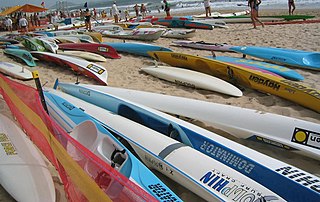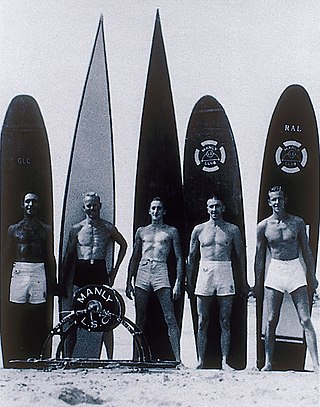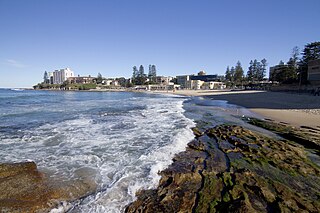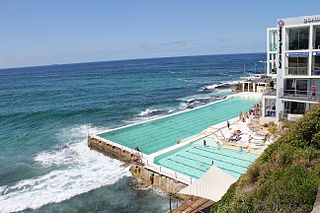
Surf lifesaving is a multifaceted social movement that comprises key aspects of voluntary lifeguard services and competitive surf sport. Originating in early 20th century Australia, the movement has expanded globally to other countries, including New Zealand, Ireland, South Africa, and the United Kingdom. Surf lifesavers in Australia are colloquially known as "Clubbies".

Clovelly is a small beach-side suburb in Sydney's Eastern Suburbs, in the state of New South Wales, Australia. Clovelly is located 8 kilometres south-east of the Sydney central business district, in the local government area of the City of Randwick, within the Federal Division of Wentworth.

Nippers are young surf lifesavers, usually aged between 5 and 14 years old, in clubs across Australia, New Zealand and South Africa. Unlike senior surf lifesavers, the majority of them do not patrol the beaches. The focus for Nippers tends to be on fun, and surf awareness.

Inflatable Rescue Boats (IRBs) are rubber boats with an outboard motor used in surf lifesaving. IRBs have been used for all forms of surf rescue, retrieval, and service by Surf Lifesaving in New Zealand, Australia, and Del Mar, California since the late 1980s.

The Manly Life Saving Club is one of Australia's oldest Surf Life Saving Clubs, founded in 1911; located in the Sydney suburb of Manly, in the Northern Beaches Council in New South Wales.

Cronulla Beach, is a patrolled beach on Bate Bay in the Sydney suburb of Cronulla, New South Wales, Australia. The Cronulla Pavilion and the Cronulla Lifesaving Club are two prominent buildings located close to the sand. Cronulla Park sits behind the beach. The Cronulla Rock Pools are between Cronulla Beach and North Cronulla beach. The Alley is the local name given to the area between Cronulla Beach and North Cronulla Beach. Shark Island is a dangerous reef break, located off Cronulla Beach.

The International Life Saving Federation (ILS) is an organisation for drowning prevention, water safety, lifesaving and lifesaving sports.

The Cronulla District LifeSaver Rescue Service works with the Water Police, NSW Police, NSW Maritime, Coast Guard, PolAir Helicopters, Westpac Life Saver Rescue Helicopters, Bate Bay Surf Life Saving Clubs as well as clubs in the Royal National Park, and CareFlight helicopters in providing rescue and emergency medical care to the people on Sydney's waterways.

Surf Life Saving Australia (SLSA) is an Australian not-for-profit community organisation that promotes water safety and provides surf rescue services.

Lifesaving is the act involving rescue, resuscitation and first aid. It often refers to water safety and aquatic rescue; however, it could include ice rescue, flood and river rescue, swimming pool rescue and other emergency medical services. Lifesaving also refers to sport where lifesavers compete based on skills, speed and teamwork. Lifesaving activities specialized in oceanic environment is called surf lifesaving or coastal lifesaving.
The club was founded in 1903 and the movement has since spread to other parts of New South Wales and the rest of the country. The club rests on indigenous land and whilst there is no clear evidence for the name or names of the Eora people who lived in what is now the Waverley area, most sources agree on the Cadigal, but some sources name the Biddigal and Birrabirragal bands as well.
The Bondi Surf Bathers' Life Saving Club is Australia's oldest Surf Life Saving Club, founded in 1907. The club was officially established on 21 February 1907 at the Royal Hotel in Bondi Beach, Sydney, New South Wales. The clubs aim is to ensure "No Lives Lost" at Bondi Beach and is a volunteer organisation that patrols Bondi Beach from October to April every year.
The Darwin Surf Life Saving Club is a foundation member of the surf lifesaving movement in the Northern Territory. It was founded in 1982 on the Casuarina Coastal Reserve in Casuarina, Northern Territory.
The North Bondi Surf Life Saving Club is a foundation member of the surf lifesaving movement in Australia. It was founded in 1907 by a group of concerned locals and has a proud history of no lives being lost whilst its members have patrolled.

The Bondi Icebergs Swimming Club is an Australian winter swimmers club, located at the southern end of Bondi Beach in Sydney, New South Wales. The swimming club was established in 1929 and has a small museum on the first floor. A defining characteristic of the Club is a rule that to maintain membership it was mandatory that swimmers compete on three Sundays out of four for a period of five years.
The Wanda Surf Lifesaving Club was established in 1946 after World War II by a group of men who banded together, from the North Cronulla Surf Life Saving Club who were being asked to patrol this stretch of beach, being a considerable distance from the Cronulla area. The colours of Army red, Air Force blue, and Navy blue were adopted as the club colours. The club, located on Marine Esplanade, has grown in size to its current membership of over 900 male and female members, ranging in age from five-year-old Nippers to the original Founding Members.
The Elouera Surf Lifesaving Club is an Australian surf lifesaving club in Cronulla, New South Wales.
The Australian Surf Life Saving Championships known as The Aussies is the national Surf lifesaving championships for Australia. It is the largest surf lifesaving event in Australia and the largest event of its kind in the world. It is organised by the Surf Life Saving Australia, and had been held annually since 1915.

Lifesaving is an official discipline of the World Games, the Games with all the sports, recognized by the IOC but not yet in the Olympic program.













